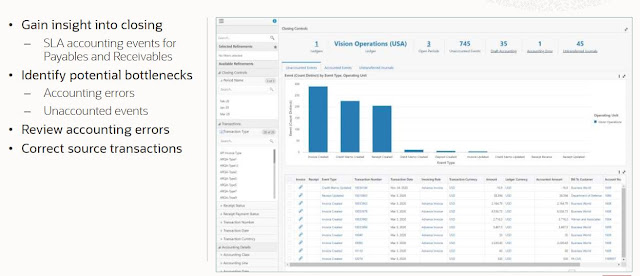The 12.2.9 release demonstrates Oracle’s commitment to a Continuous Innovation release model for Oracle E-Business Suite 12.2. With Continuous Innovation, Oracle E-Business Suite 12.2 customers can continue to access new applications functionality and separately uptake later versions of underlying technology, all without the time and expense of a major release upgrade. In addition, customers can count onPremier Support for Oracle E-Business Suite 12.2 through at least 2030.
New Functionaland TechnicalCapabilities Across Oracle E-Business SuiteThe 12.2.9 release includes the following new features and enhancements:
Financials: Oracle Property Manager improves support for IFRS16 and ASC842 from an accountingand operationalperspective. Processing of bookings, terminations, and accrual transactions is now more flexible, with bookings and terminations supported retrospectively. Amendments processing supports multiple same-period amendments, categorization of amendments, and improved audit capture. Oracle Lease and Finance Management improvesend-to-end throughputfor the organization. For example, you can now streamline contract changes that don’t involve any financial changes to a lease, such as changing lease terms and conditionsor updating address information for the lease contract counterparty. Investor agreementimprovementsincludecontract-level accountingand investor disbursement schedules. Additionalenhancements include new web services and mobile approvals.
Procurement: With Oracle Purchasing, organizations can define and capture additional business attributes in purchase order documents to communicateunique procurement needs to suppliers.Oracle Procurement Contracts and Oracle Sourcing enable supplier and buyer legal teams to conduct online negotiation of contract terms.Approvals Management Engine (AME) workflows are integrated with Oracle Sourcing and Oracle Supplier Lifecycle Management to enable approvals by multiple users and teams ─for example, for approval of requirements specified in a negotiation, or approval of questionnaire details ina supplier assessment. Oracle iProcurement increases control andreduces errors by requiring requesters to enter the outstanding quantity to be received.
Projects: Oracle ProjectBillingprovidesbill groups for flexible categorization of transactionsto meet the unique billing needs of a project. New capabilities include revenue accrual and consolidated invoicing by bill group. Additionalenhancements improve control and efficiency in project accounting and budgeting. For example, Project Billing adds support for generating revenue in the same currency as costs to easily match revenue to costs. Project Costing uses the same budget for project funds check as for corporate (GL) funds check.
Order Management: Oracle Order Management extends its support for recurring payment streams with ausage-based billing option to automatically generate invoices based on customerusage. Use cases include subscriptions and rental contracts, which oftenare billed based on the actual usage of underlying productsor services.Additional enhancements enable streamlinedprocessing oforders, returns, and price lists.For example, order management analysts can receive returns in any unit of measure. Organizations can optimize order pricing with user-defined attributes that trigger repricing.
Manufacturing: Oracle ProcessManufacturingprovidesserialization support for industriessuch as life sciences, chemicals, and consumer goodsthat require traceability of the supply chain. In “Make to Order” scenarios, production batches can now be configured with process instructions that are tailored to specifics of the customer order. Support for parallel approvers greatly enhances the usability of quality management workflows. Oracle Discrete Manufacturingprovides increased visibility and improved production controls. Operators can view on-hand quantities of components across sub-inventories during production. Material consumption during manufacturing can be better controlled with flexible configuration rules.
Asset Lifecycle Management: Oracle Enterprise Asset Management enhanceswork request approvals using AME. Additional enhancements further streamlineasset management and maintenance operations. For example, work request resolution dates can be defaultedbased on setup, and work orderdescriptions can expandto2000 characters. Enhanced Geographic Information System (GIS) mapping improves visibility to assetstatusand work requestactions.
Logistics: Oracle Inventory Managementadds workflow-driven cycle count approvals withthe Approvals Management Engine (AME.) It also streamlinesbackorder processingwith several enhancements,including theautomated cancellation of unshipped order linesfor customers thatdo not acceptbackorders. Oracle Mobile Supply Chain Applications(MSCA) introducesmulti-field barcodes, which simplifies data entry and provides better compliance with the newFDA (GS1) and European (PPN) specifications. In Oracle Warehouse Management,the“verify pick” functionality provides the opportunity forsomeonetoverifya pick before it progresses to the next step, reducingshipping errorsand return merchandise authorizations (RMAs)while improvinginventory accuracy.
Service: OracleService supports chargesintegration with Oracle Advanced Pricing to allow item charges, such as for replacement parts, to be priced using Advanced Pricing rules. With anew prescriptive recommendation capability, Oracle Depot Repairproposesroot causesand recommendsbest fixesbased on past service orders.Additionalenhancementsincrease control and flexibility of service deliverymanagement. For example, Advanced Scheduler can limit planned versus reactive work performed by service technicians, and can capture a reason code for a missed service level agreement (SLA.) Teleservice can send workflow notifications to non-employees, including to suppliers andfield service partners.
Human Capital Management: Oracle Time and Laboroffersmass upload of employee time card entries along with an enhanced time card retrieval dashboard to save administrator and line manager effort.Additional enhancementsenableproductivity gainsacross the HCM product family. For example, updates to Self-Service Human Resources(SSHR)informationnow trigger email confirmations. In Canada, employees can view and update their tax informationvia SSHR. In the US, ex-employees can view and downloadSSHR payslips and W-2 forms.
Applications Technology: Enhancements totheOracleApplication Framework (OAF)improvethe user experience of HTMLUIs. New “list search” functionalitysimplifies table searchesin many high-use HTMLpages.With list search,users canview saved table searchesas infotiles. Users alsocanselect filter values displayed next to a table, including values derived from descriptive flexfields. AdditionalHTMLenhancements includea simplified table toolbar, and popups for lists ofvalues, date picker, key flexfields, and descriptive flexfields, Oracle Workflow provides enhanced options for configuring email notification attachments, and supports dateand timedisplayin the user’s preferred time zone.
Formore informationon functional andtechnical innovationsin Release 12.2.9. Refer Oracle E-Business Suite Releases 12.1 and 12.2 Release Content Documents(Doc ID 1302189.1),
Oracle E-Business Suite Release 12.2.9 Readme-2495027.1
Reference: support.oracle.com







